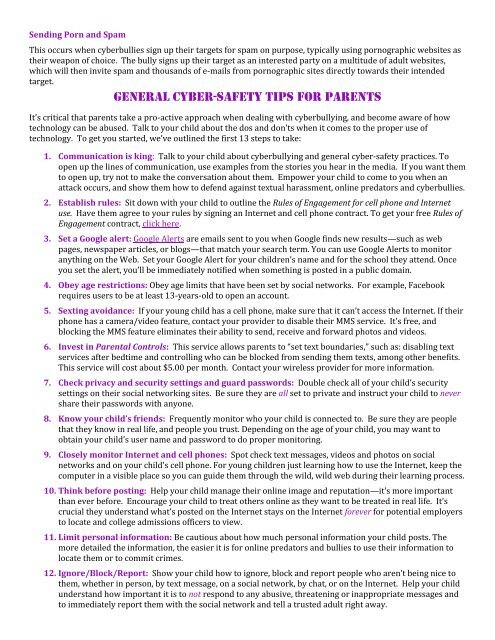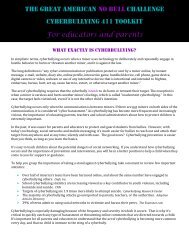The Great American NO BULL Challenge cyberbullying 411 toolkit ...
The Great American NO BULL Challenge cyberbullying 411 toolkit ...
The Great American NO BULL Challenge cyberbullying 411 toolkit ...
You also want an ePaper? Increase the reach of your titles
YUMPU automatically turns print PDFs into web optimized ePapers that Google loves.
Sending Porn and Spam<br />
This occurs when cyberbullies sign up their targets for spam on purpose, typically using pornographic websites as<br />
their weapon of choice. <strong>The</strong> bully signs up their target as an interested party on a multitude of adult websites,<br />
which will then invite spam and thousands of e-mails from pornographic sites directly towards their intended<br />
target.<br />
General Cyber-Safety Tips for Parents<br />
It’s critical that parents take a pro-active approach when dealing with <strong>cyberbullying</strong>, and become aware of how<br />
technology can be abused. Talk to your child about the dos and don’ts when it comes to the proper use of<br />
technology. To get you started, we’ve outlined the first 13 steps to take:<br />
1. Communication is king: Talk to your child about <strong>cyberbullying</strong> and general cyber-safety practices. To<br />
open up the lines of communication, use examples from the stories you hear in the media. If you want them<br />
to open up, try not to make the conversation about them. Empower your child to come to you when an<br />
attack occurs, and show them how to defend against textual harassment, online predators and cyberbullies.<br />
2. Establish rules: Sit down with your child to outline the Rules of Engagement for cell phone and Internet<br />
use. Have them agree to your rules by signing an Internet and cell phone contract. To get your free Rules of<br />
Engagement contract, click here.<br />
3. Set a Google alert: Google Alerts are emails sent to you when Google finds new results—such as web<br />
pages, newspaper articles, or blogs—that match your search term. You can use Google Alerts to monitor<br />
anything on the Web. Set your Google Alert for your children’s name and for the school they attend. Once<br />
you set the alert, you’ll be immediately notified when something is posted in a public domain.<br />
4. Obey age restrictions: Obey age limits that have been set by social networks. For example, Facebook<br />
requires users to be at least 13-years-old to open an account.<br />
5. Sexting avoidance: If your young child has a cell phone, make sure that it can’t access the Internet. If their<br />
phone has a camera/video feature, contact your provider to disable their MMS service. It’s free, and<br />
blocking the MMS feature eliminates their ability to send, receive and forward photos and videos.<br />
6. Invest in Parental Controls: This service allows parents to “set text boundaries,” such as: disabling text<br />
services after bedtime and controlling who can be blocked from sending them texts, among other benefits.<br />
This service will cost about $5.00 per month. Contact your wireless provider for more information.<br />
7. Check privacy and security settings and guard passwords: Double check all of your child’s security<br />
settings on their social networking sites. Be sure they are all set to private and instruct your child to never<br />
share their passwords with anyone.<br />
8. Know your child’s friends: Frequently monitor who your child is connected to. Be sure they are people<br />
that they know in real life, and people you trust. Depending on the age of your child, you may want to<br />
obtain your child’s user name and password to do proper monitoring.<br />
9. Closely monitor Internet and cell phones: Spot check text messages, videos and photos on social<br />
networks and on your child’s cell phone. For young children just learning how to use the Internet, keep the<br />
computer in a visible place so you can guide them through the wild, wild web during their learning process.<br />
10. Think before posting: Help your child manage their online image and reputation—it’s more important<br />
than ever before. Encourage your child to treat others online as they want to be treated in real life. It’s<br />
crucial they understand what’s posted on the Internet stays on the Internet forever for potential employers<br />
to locate and college admissions officers to view.<br />
11. Limit personal information: Be cautious about how much personal information your child posts. <strong>The</strong><br />
more detailed the information, the easier it is for online predators and bullies to use their information to<br />
locate them or to commit crimes.<br />
12. Ignore/Block/Report: Show your child how to ignore, block and report people who aren’t being nice to<br />
them, whether in person, by text message, on a social network, by chat, or on the Internet. Help your child<br />
understand how important it is to not respond to any abusive, threatening or inappropriate messages and<br />
to immediately report them with the social network and tell a trusted adult right away.








